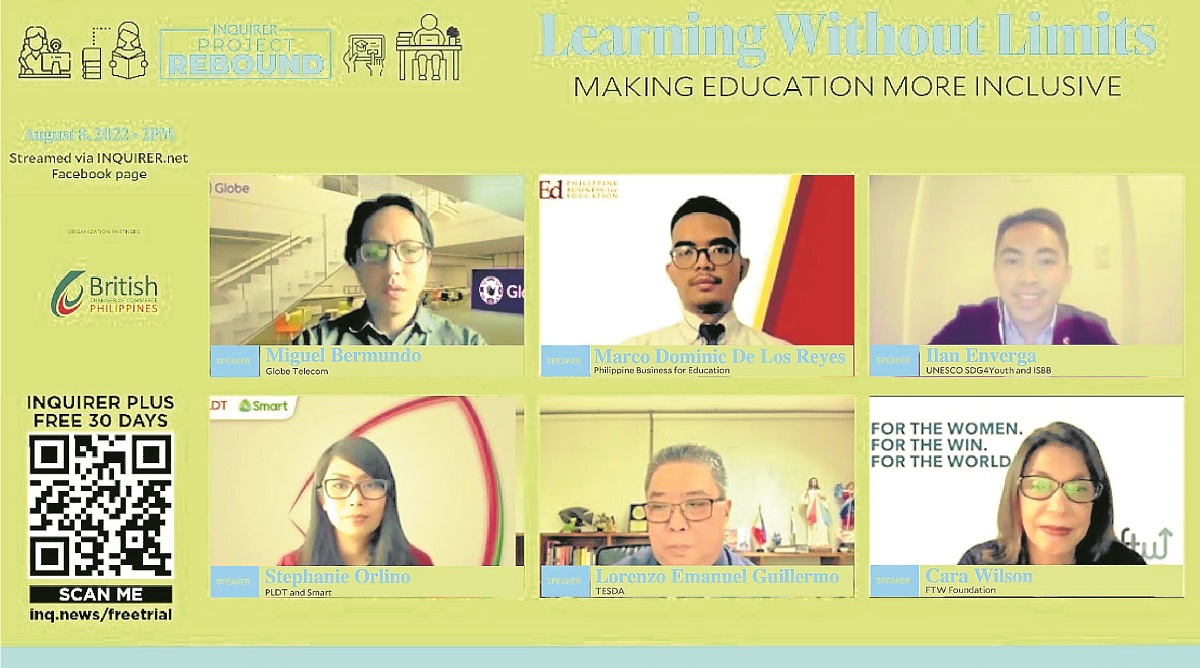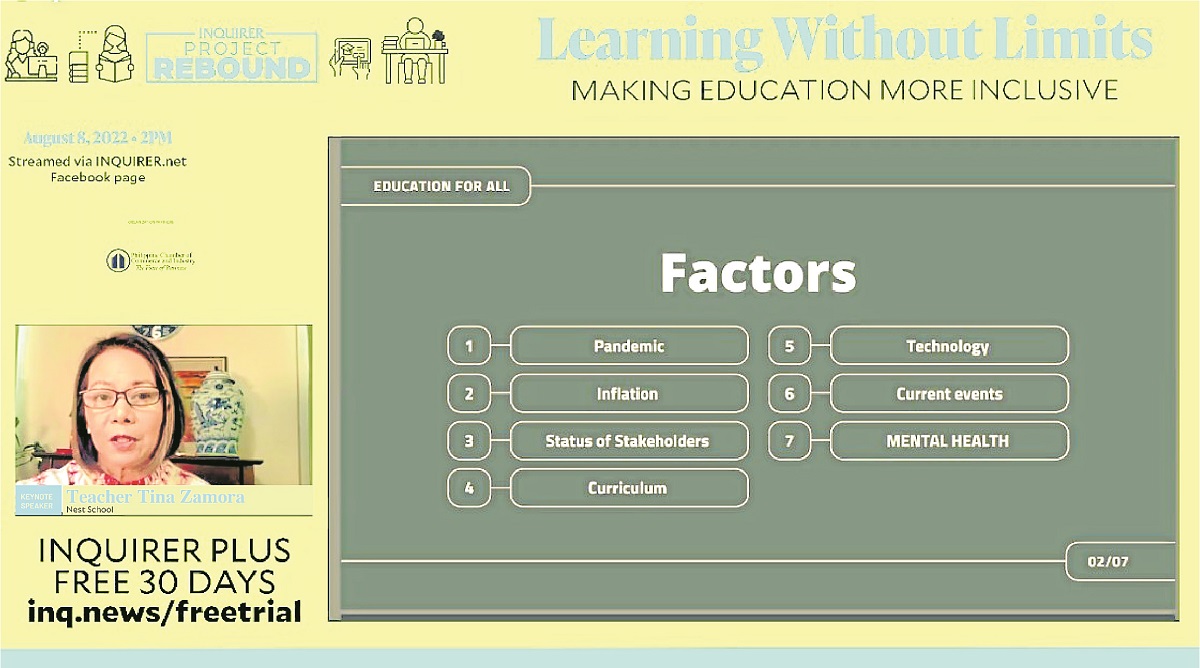At present, the Philippines has around 26 million students. But the number of stakeholders—the people also involved in these students’ education—goes far beyond that.
Family life and child development specialist Teacher Tina Zamora pegs the number of education stakeholders to a whopping 90 million, out of the country’s population of 115 million. “Learning doesn’t exist in a vacuum, and the learner doesn’t exist outside the context of the many factors in [their lives],” Zamora said in the recent Inquirer Project Rebound webinar for education.
“Most of the time when we hear phrases like, ‘no student should be left behind,’ or ‘quality education for all,’ it usually connotes the need for finances and to help the underprivileged and the poor or those who have no access to quality education. And so we only zone in to these particular factors,” she says. However, there’s more to that.
The context includes what is happening to learners’ or students’ families, schools including teachers, communities, peer groups, and society as a whole. Add to this various other factors such as inflation, the availability and development of technology, and even their and their immediate circle’s mental health.
Thus to fully address the challenges our educational system currently faces, all these factors must be considered, too.
Digitalization
The Department of Information and Communications Technology cites Statista saying that the country logged almost 80 million internet users and reported a 72 percent internet penetration rate as of February 2022.
The numbers appear to be well-founded if we look at how technology and the internet have become the primary medium for socialization, entertainment, education, business, financial transactions, and commerce throughout the pandemic. However, taking a closer look at access and usage, particularly in the education sector, reveals some inequities.
The pandemic prompted many tech and telecommunication companies to step up in terms of distribution, not just of their primary services, but also added forms of assistance. For example, besides providing educators or students with internet or data access, gadgets or devices are also provided, along with other learning tools.
PLDT-Smart, for example, launched their “School-In-A-Bag” program, which aims to distribute packages containing pocket wifi, laptops for teachers, and tablets for students, with pre-loaded educational content that can be accessed offline.
Globe Telecom, meanwhile, worked with the Department of Education (DepEd), Commission on Higher Education (CHED), and the Technical Education and Skills Development Authority (TESDA) to create learning platforms that could be accessible for Globe subscribers without incurring data charges. A free e-library that contains free, public-domain e-books was also made accessible for learners and parents.
More than just equipping students and teachers with the right tools, companies like ASUS also partner with whole educational institutions in improving and modernizing IT facilities, as well as providing tech training.
However, even after connectivity and tools are provided, other challenges still abound. UNESCO SDG4Youth Network representative Ilan Enverga notes the importance of strengthening digital literacy in the country. “As Teacher Tina mentioned, current events is one of the really big factors that education needs to open itself to. And one of the issues in the Philippines is disinformation and fake news.”
“When we talk about digital or technological inequality or inequity, we can see in the Philippines that lack of digital literacy is, unfortunately, more predominant among lower classes,” Enverga says.
Aside from digital literacy, other issues surrounding digital connectivity abound. Burnout from online classes, cyberbullying and other mental health concerns, social media responsibility, cybersecurity, and the youth’s increased vulnerability online are among the issues to address.
PLDT-Smart’s head of stakeholder management of corporate communications Stephanie Orlino emphasized the importance of keeping children safe online. The telco’s platform reportedly has been able to block over a billion attempts to access URLs containing child sexual abuse materials—terrifying proof that more work needs to be done to ensure internet safety for all.
Likewise, Globe launched their Make IT Safe PH program, which aims to help parents and guardians stay updated on threats and dangers online. This includes informing adults about the language used online, to help them spot and flag potentially threatening content or conversations from their children. This is especially relevant as most youth interactions now happen in various online spheres.
Lifelong learning
Despite the challenges, the potential and benefits of online learning seem to outweigh the difficulties. For instance, online learning has made it possible for us to review and implement new forms of learning. Wider implementation of educational programs online also opened opportunities for those out of school, or those interested in upskilling, to continue learning, in their own time and space.
Cara Wilson, co-founder and executive director of For The Women (FTW) Foundation, notes how most of their successful graduates are actually those who are returning to the workforce after having been stay-at-home mothers. “I think it’s also because… they know exactly what they want and so they go for it in the way that we encourage very much. We look for these gritty, career-driven [people] at FTW,” she says. FTW helps upskill Filipinas through training scholarships in technology.
Orlino echoes this, saying, “I think the shift to online or distanced learning has made it easier and more attractive to finish your studies or pursue secondary studies. And with the opening up of the informational gateway which is enabled by technology, there’s now a wider range of content that can be pursued aligned with your varying interests.” Making access to educational content easier financially and with more flexible hours, she says, helps in encouraging lifelong learning.
But aside from online courses and educational content, establishing easily accessible training programs on various platforms can also help. Dir. Lorenzo Emanuel Guillermo, executive director of the qualifications and standards office of TESDA, shares that the agency is able to cater to a wide age range of learners, from senior high school students and out-of-school youth who need to start working, up to retirees who are in need of entrepreneurial skills for their retirement business plans.
“The importance of this became even more apparent during the pandemic, with even professionals establishing their own businesses and OFWs who were left without jobs. They were forced to find alternative ways to get employed,” Guillermo says. “In TVET (technical vocation education and training), we don’t see the stigma of a young and an old learner going back to school.”
With myriad learning opportunities available now, other educators and education experts also emphasize the importance of equipping younger learners with not just knowledge, but the proper influence.
Enverga notes that despite having a new generation of learners, today’s kids retain the same typical work aspirations. He attributes this partially to the tendency to stick to the familiar, but also the influence parents and guardians have on their children. “Whatever jobs are valued most by the generations of today’s parents, those same values significantly influence today’s youth,” he says.
Echoing a point in Zamora’s keynote speech about how easily impressionable and influenceable children are, Enverga encourages fellow education stakeholders to “expose them at a young age to jobs that our country needs for the future, not only for the trending digital economy… but also for jobs in the green economy.”









